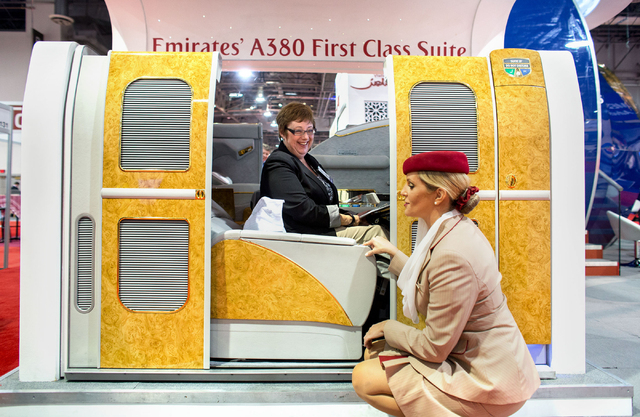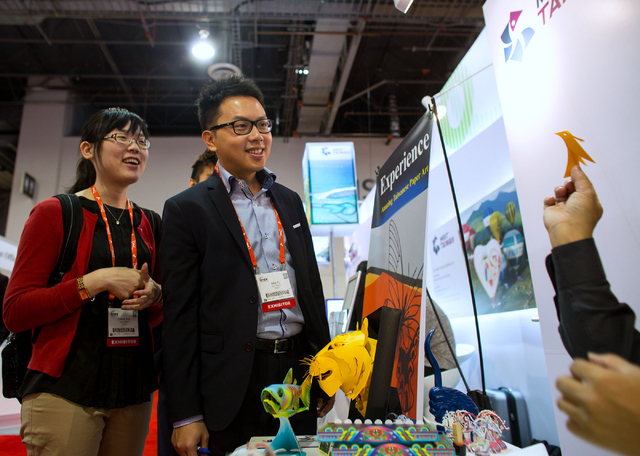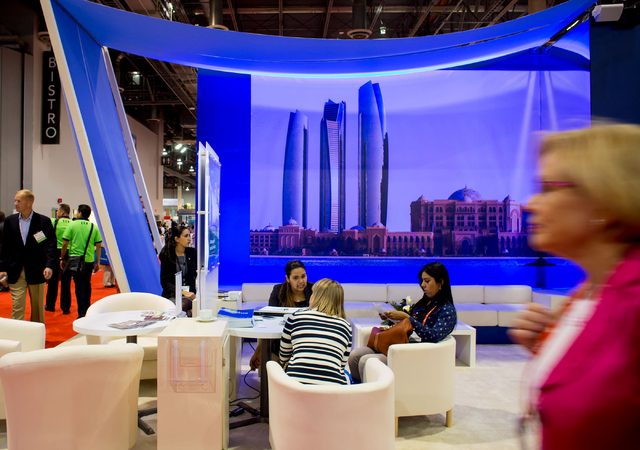Meeting industry zeroes in globalization, technology
Globalization, technology and new development were among the themes this week at IMEX America 2013, an exhibition for incentive travel, meetings and events.
The international conference, with more than 170 education sessions, 80 new booths and 2,694 exhibiting companies spread across 260,000 gross square feet, is in Las Vegas through today at the Sands Expo and Convention Center.
For its third year in America, overall booth space increased by 17 percent compared with last year, and the number of exhibitors was up 12 percent from last year’s 2,413.
New booths include 11 hotel groups and 24 destinations and suppliers from across the U.S., Jordan, the British Virgin Islands and the Bahamas. Of the returning exhibitors, 37 percent, or 86, increased their booth sizes, with a third of those doubling, or more than doubling, their size.
“Certainly there is growth in the industry, although in the last five to seven years it’s been tough financially. It’s a very resilient industry, because of course to share ideas, people have to meet face to face,” said Carina Bauer, IMEX Group CEO.
Returning exhibitor Germany has 35 exhibitors within its booth, including the Stuttgart Convention Bureau, Maritim Hotels and KÖLNDÜSSELDORF-The Meetropolis. Last year, 362 million people attended meetings in Germany.
The German Convention Bureau this year conducted the Global Meetings 2030 Future Study. The research looked at megatrends that will have an impact on the meetings industry in the next 15 years or so.
“The most important megatrend that will have the most impact on our industry is technology,” said Matthias Schultze, managing director of the German Convention Bureau.
Wi-Fi and connectivity are hot topics, Bauer said, as people expect to be able to connect almost anywhere.
“That’s something I know venues are dealing with, and who should pay for that is always an issue,” she said.
Looking to the future, globalization is inevitable, Schultze said, as more international meetings are needed to solve problems as the number of global businesses grow.
In Germany in 2006, 14 million people from international destinations attended meetings. In 2010, that number grew to 60 million, and by 2020 it is expected to grow to 80 million.
That means new competition, new target groups and new intercultural requirements for destinations.
“Globalization is already ongoing,” said Karina Gruetzner, business development manager at the Stuttgart Convention Bureau.
Xavier Guillemin, meetings and events market director for Accor, a French hotel company, said more Chinese and Indian people are staying at Accor’s hotels, so adapting products to the global world is important.
“We need to be global and match all the needs of our clients; … at the same time, the French touch is important,” Guillemin said.
Julie Kruger, business development manager for Dusseldorf Congress, said more women are attending health care-related shows than ever before, and that number is projected to rise. She said women tend to like smaller, more intimate meetings and less chaotic experiences than what may happen on a typical trade show floor.
Gruetzner said gender demographic changes within conferences lead to new trade show formats, including more well-being and fitness aspects, as female attendees express interest in them.
“Our show and our industry is very female-dominated, but it always has been,” Bauer said.
In terms of how shows are planned, gender is taken into consideration.
“It probably does change the way we do things,” Bauer said.
On the show floor, Michael Stokoe, business events executive for Tourism New Zealand, was taking meetings with potential buyers and highlighting what’s new in his country. Among his topics were the new convention centers slated to be operational by 2017 or 2018, located in Auckland, Queenstown and in Christchurch as part of the latter’s rebuilding after the 2010 and 2011 earthquakes that damaged much of its infrastructure.
“They’ve done a lot of the groundwork for a lot of the rebuild, and they haven’t had tremors for quite a while now, so a lot of the old damaged buildings are gone now,” Stokoe said.
Four new hotels have opened in Christchurch recently, and more are set to be refurbished or built.
“It’s definitely coming ahead. We’re all looking forward to the rebuild and it getting back to its vibrant self again,” Stokoe said.
Closer to home, Nashville, Tenn., recently completed a 1.2 million-square-foot convention center, and a headquarter hotel, the 800-room Omni, opened a few weeks ago. Fourteen hotel projects are going on around the city, and other properties, such as the Hilton, Renaissance and Embassy Suites, are renovating. Nashville has about 33,000 hotel rooms now.
“The product level is just incredible,” said Jerelle Gordon, director of the West Coast office for the Nashville Convention and Visitors Bureau.
In Anaheim, Calif., the Anaheim Convention Center Grand Plaza, a 100,000-square-foot outdoor special events space, was completed this year. Designed to be an enhancement for the convention center, the grand plaza provides additional space for exhibits, transportation flow and concerts.
Construction on Anaheim’s $29.2 million Regional Transportation Intermodal Center is moving ahead, after the project broke ground in late 2012.
The project is slated for completion in late 2014 and is designed to facilitate easy transitions among Southern California’s transit services.
Contact reporter Laura Carroll at lcarroll@reviewjournal.com or 702-380-4588. Follow @lscvegas on Twitter.

























